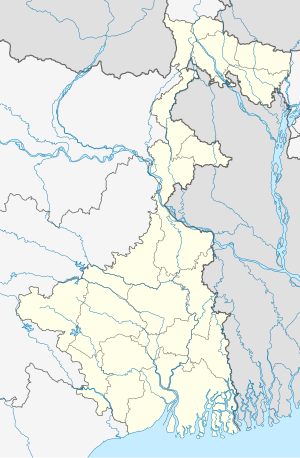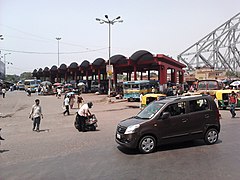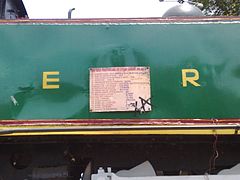Howrah railway station
Howrah railway station, also known as Howrah Junction, is a railway station located in the city of Howrah, West Bengal, India.[7] It is the oldest and largest existing railway complex in India.[8][9] It is one of the busiest train stations in the world.[10] About 600 passenger trains pass through the station each day, utilising its 23 platforms, and serving more than one million passengers per day.[2] Howrah is one of five intercity train stations serving the Kolkata metropolitan area (including Howrah and its twin city of Kolkata), the others being Sealdah, Santragachi, Shalimar and Kolkata railway stations.
Toponymy[edit]
Eastern Railway, who operate the station, refer to the station as "Howrah". Indian Railways refers to the station as "Howrah Junction". The station is more colloquially referred to as "Howrah Station".
History[edit]
On 17 June 1851, George Turnbull, the Chief Engineer of the East Indian Railway Company and his team of engineers submitted plans for a railway station at Howrah. In January 1852, the government authorities decided not to purchase the land and expensive water frontage needed for the project, not then realising the future importance of railways. Turnbull then developed other plans to cost an estimated 250,000 rupees. In October 1852, four tenders for the building of the station were received: they varied from 190,000 to 274,526 rupees. The first locomotive left Howrah on 18 June 1853 for the 37.5 miles to Pundoah.
Great crowds celebrated the first public departure from Howrah for the 23.5 miles to Hooghly on 15 August 1854.[11][12][13]
The increase of residents in the region around Howrah and Kolkata and the booming economy lead to an increasing demand for rail travel. Also, the rail network kept on growing continuously, e.g. was the Bridge over the Rupnarayan River at Kolaghat completed on 19 April 1900 and connected Howrah with Kharagpur.[14] The Bengal-Nagpur Railway was extended to Howrah in 1900, thus making Howrah an important railway centre.[15] So in 1901, a new station building was proposed. The British architect Halsey Ricardo designed the new station.[15] It was opened to the public on 1 December 1905.[16][15] This is the current Howrah station building including 15 platform tracks.
On 3 March 1969, the first Rajdhani Express left Howrah for New Delhi.[17][13]
In the 1980s, the station was expanded to include 8 new platforms on the south side of the station. At the same time, a new Yatri Niwas (transit passenger facility) was built south of the original station frontage.
Until 1992 there was a tram terminus at Howrah Station. Trams departed for Sealdah Station, Rajabazar, Shyambazar, High Court, Dalhousie Square, Park Circus, Ballygunge, Tollygunge etc. Trams also departed for Bandhaghat and Shibpur. The tram terminus was partially closed in 1971 while the Bandhaghat and Shibpur lines were closed. Many unauthorized vehicles and pedestrians began to traverse the tram tracks and so the routes were not continued. The terminus station was converted to underpasses and a bus terminus. The part of the tram terminus for other routes continued to function until 1992, when the Rabindra Setu (Howrah Bridge) was declared unfit to carry trams because it was a cantilever bridge.
The new terminal complex was finished in 1992, creating a total of 19 platforms.[13] This was extended by a further 4 platforms in 2009.[13]
In October 2011, India's first double-decker train left Howrah for Dhanbad.
The first service of the Antyodaya Express started on 4 March 2017 between Ernakulam Junction and Howrah.
Heritage museum[edit]
The nearby Rail Museum, Howrah opened in 2006 contains a section dedicated to the heritage and history of Howrah railway station.[18]
Rail services[edit]
The Eastern Railway runs local trains to Belur Math, Tarakeswar, Arambagh, Goghat, Katwa, Bandel, Sheoraphuli, Bardhaman, Serampore and numerous intermediate stations (see Howrah–Bardhaman main line, Howrah–Bardhaman chord and Tarakeswar branch line). There are also mail and express trains to Central, North and North-East India. A narrow-gauge line formerly used to connect Bardhaman and Katwa, served by DMU trains; but now this line is also converted to broad gauge and used by EMU trains like all the other lines.[19]
The South Eastern Railway, operates local trains to Amta, Mecheda, Panskura, Haldia, Tamluk, Medinipur and Kharagpur and mail and express trains to Central, West and South India. South Eastern Railway, connects with the Great Indian Peninsular Railway (GIPR) route to Mumbai and Chennai.
The Eastern Railway and South Eastern Railway sections are connected by two links. One is the Lilua–Tikiapara link and the other is the Rajchandrapur–Dankuni-Mourigram link. They are used by goods trains and the Sealdah–Puri Duronto Express avoiding Howrah.
Four major rail routes end at Howrah. They are the Howrah–Delhi, Howrah–Mumbai, Howrah–Chennai and Howrah–Guwahati routes.
After completion Kolkata Metro Line 2 will pass through Howrah Station.[20]
Station facilities[edit]
The station is the divisional headquarters for the Eastern Railway.
The station has 23 platforms. Platforms 1 to 16 are located in the old complex, referred to as "Terminal 1". It serves the local and long-distance trains of Eastern Railway and local trains of South Eastern Railway. Platforms 17 to 23 are in the new complex, referred to as "Terminal 2". It serves the long-distance trains of South Eastern Railway.
There is a large covered waiting area between the main complex and the platforms and other areas for passengers awaiting connecting trains. Google provides RailWire Free high-speed WiFi. In addition, there is a transit passenger facility with dormitory, single-room and double-room accommodation. First-class passengers wait in an air-conditioned area with balcony views of the Kolkata Skyline and the Howrah Bridge.
The station platforms have carriageways for motor vehicles within the complex including two carriageways to platforms 8 and 9 for Eastern Railway and to platforms 21 and 22 for South Eastern Railway. Flyovers at the ends of the platforms allow motor vehicles to exit the complex quickly.
Sampath Rail Yatri Niwas and Regional Rail Museum are a part of "Terminal 2" Howrah station complex.[21][22]
The railway museum, located south of the station, displays artefacts of historical importance related to the development of Eastern Railway. For many years the Fairy Queen, the world's oldest operational steam locomotive, was displayed on a plinth inside the station.[23]
Services for rolling stock[edit]
The station has a diesel-locomotive shed with room for 84 locomotives. The electric-locomotive shed has room for 96 locomotives. There is also an electric-trip shed with the capacity to hold up to 20 locomotives. The sheds accommodate 150+ WAP-4, WAP-5, and WAP-7 locomotives. The EMU car shed has over 15 parking slots. The station has a coach maintenance complex.
Metro station[edit]
Howrah Station will also get an underground station as part of Line 2 of the Kolkata Metro.[24] It will be the deepest station on the East-West Metro line of the Kolkata Metro[20][25] and further the deepest in the country.[26] The connecting metro stations will be Howrah Maidan to the west and Mahakaran to the east. The station is expected to open in 2021.[citation needed]
Gallery[edit]
- First locomotive india1854 photo1894.jpg
The first locomotive, shown on the right and christened "multum in parvo" (barely visible on the wheel casing), which was used by the East Indian Railway Company in 1854 on its 23-mile line from Howrah to Pandua.
- Howrah YN.jpg
Yatri Nivas (Travellers' Lodge) at Howrah station
See also[edit]
- Kolkata Metro
- Kolkata railway station
- Kolkata suburban railway
- List of Kolkata Metro stations
- Santragachi railway station
- Sealdah railway station
- Shalimar railway station
- Trams in Kolkata
References[edit]
- ↑ "[IRFCA] Indian Railways FAQ: Electric Traction – I". IRFCA. Retrieved 13 June 2012.
- ↑ 2.0 2.1 "Passengers run riot in Howrah". The Telegraph India. 27 October 2019. Retrieved 4 January 2020.
- ↑ Google Maps
- ↑ Kharagpur-Howrah Local 38606 Indiarailinfo
- ↑ Howrah-Haldia Local 68689 ⇒ 38089 Indiarailinfo
- ↑ Santragachi-Digha EMU 78001 ⇒ 68687 Indiarailinfo
- ↑ "Howrah JN (HWH) railway station". NDTV Rail Beeps. Retrieved 4 August 2020.
{{cite web}}: CS1 maint: url-status (link) - ↑ অযান্ত্রিক (18 November 2015). "Howrah Railway Junction Station, Howrah, 1854 –". puronokolkata. Retrieved 20 October 2020.
- ↑ "Third oldest railway station in country set to turn 156 | Deccan Chronicle". web.archive.org. 29 June 2012. Retrieved 20 October 2020.
- ↑ Pritchard, Tim (4 April 2019). "The daily commute at Howrah Station is on a biblical scale as half a million passengers pour off trains". The Mirror. Retrieved 5 April 2019.
- ↑ Diaries of George Turnbull (Chief Engineer, East Indian Railway Company) held at the Centre of South Asian Studies at Cambridge University, England
- ↑ George Turnbull, C. E . pages 110, 121, 122, 125 and 127 of the 437-page memoirs published privately 1893, scanned copy held in the British Library, London on compact disk since 2007
- ↑ 13.0 13.1 13.2 13.3 "Howrah Station". er.indianrailways.gov.in. Eastern Railway. Retrieved 5 April 2019.
- ↑ "A bridge over Roopnarayan". The Telegraph. Kolkota: The Telegraph India. Retrieved 16 April 2020.
- ↑ 15.0 15.1 15.2 Sen, Swagata (19 December 2005). "Howrah station centenary celebrations: A tribute to the history it has witnessed". India Today. Retrieved 3 April 2019.
- ↑ "Howrah Station is veritably the heartbeat of Kolkata". Business Line. 2 December 2005. Retrieved 2 January 2009.
- ↑ "Howrah–New Delhi Rajdhani Express Service completes glorious 50 yrs in passenger service". United News of India. 4 March 2019. Retrieved 3 April 2019.
- ↑ Gangopadhyay, Uttara (24 November 2018). "Go Railfanning at This Little Known Museum in Howrah". Outlook India. Retrieved 16 June 2020.
- ↑ "Baro rail Katwae, jamlo bhidr (Big railway in Katwa, crowd gathers)". Ananda Bazar Patrika (in Bengali). 13 January 2018. Retrieved 13 January 2018.
- ↑ 20.0 20.1 Gupta, Jayanta (4 August 2018). "Kolkata: Another station comes up below Howrah station". The Times of India. Retrieved 5 April 2019.
- ↑ "New visiting time for Howrah Rail Museum – RailNews Media India Ltd". railnews.in. Retrieved 2 March 2018.
- ↑ "IRFCA – The Indian Railways Fan Club Photo Gallery – Howrah Railway Museum". IRFCA. Retrieved 2 March 2018.
- ↑ Ahrons, E. L. (1966). The British Steam Railway Locomotive. Vol. I, to 1925. Ian Allan. p. 142.
- ↑ "India's deepest Metro station comes up 30m below Howrah railway station".
- ↑ "Metro prepares completion calendar for city projects". The Times of India. Retrieved 7 February 2018.
- ↑ "Kolkata Metro's Howrah station by Indian Railways is India's deepest subway station! Check first look". The Financial Express. 19 August 2019. Retrieved 8 December 2019.
- Articles with unsourced statements from March 2019
- Articles using Infobox station with markup inside name
- Articles using Infobox station with links or images inside name
- Articles with unsourced statements from April 2019
- Howrah railway division
- Kolkata Metro stations
- Kolkata Suburban Railway stations
- Railway stations opened in 1854
- Railway stations in Howrah district
- Railway stations in Kolkata
- Tourist attractions in Howrah
- Rail transport in Howrah
- Railway terminus in India
- Indian Railway A1 Category Stations
- 1854 establishments in India
















